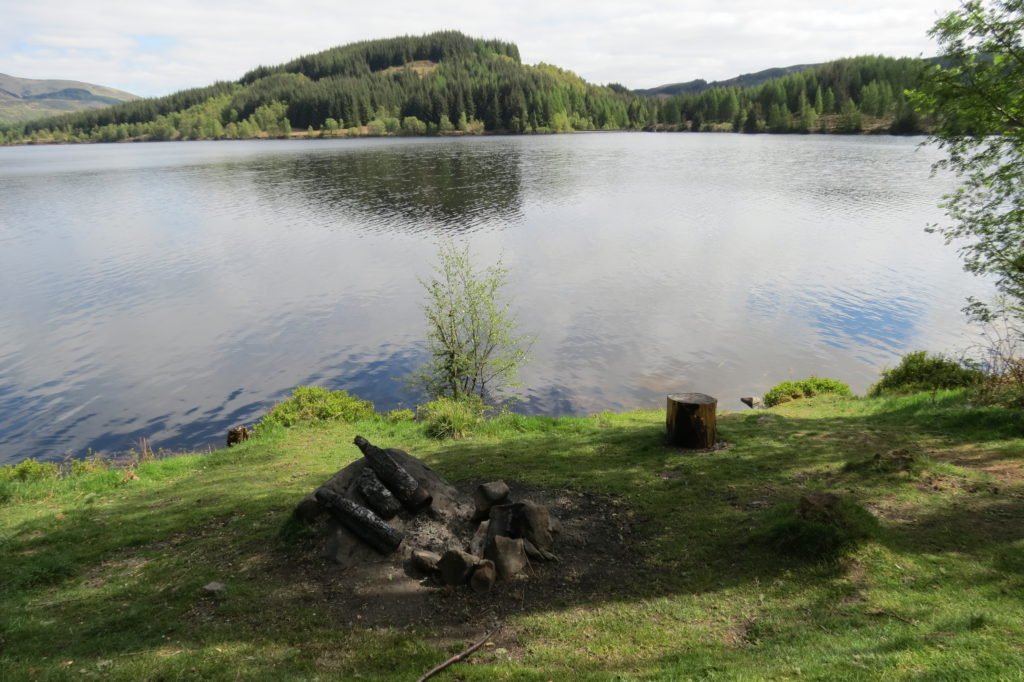
Following the inflammatory facebook post from Rothiemurchus estate on campers here and here I had not appreciated the Cairngorms National Park Authority had issued a short new release please tread lightly. Its tone is highly commendable, highlighting just how inflammatory the Rothiemurchus was, and the message a positive one: “We want people to enjoy the Cairngorms National Park and have a great holiday but not at the expense of our wildlife and the important habitats that support them”.
The one part of the message I would question is the “never light a fire in woodland or peaty soil” – the issue being what is meant by woodland or peaty soils?”. Yes, lighting fires against the base of trees, as is claimed to have happened with the granny pine, is something that I don’t think is ever justifiable but what about in woodland clearings?
Remains of fire in former camping place off Forest Drive, Trossachs – does this count as woodland in CNPA’s thinking?
The challenge here is about how to convey messages about behaviour without presenting everything as black and white. So, there may be little risk in anyone lighting a fire in the clearing pictured above, so long as it was not so big that sparks flew into the trees or the wind was blowing sparks or……….(there are a number of possible other “ors”). The point is that decisions on these things require personal judgement and need to consider a number of factors. I would like to see messages about “responsible” behaviour becoming more educative. To give them further credit the CNPA in their News Release have mainly taken that approach.
The contrast with our other National Park is stark. Loch Lomond and Trossachs National Park Authority has a complete downer about fires and in the Your Park consultation published photos of remains of old camp fires as proof that fires were a problem. I have previously pointed out that the area of vegetation impacted is miniscule – and of no ecological significance – while the woodland the LLTNPA claims to be so concerned about is mainly a product of coppicing for charcoal.
What I have just realised though is what the “evidence” on fires from the Keep Scotland Beautiful Litter Audit used by the LLTNPA in their bye-law submission to Ministers tells us:
“During the audit 709 fire sites were recorded. The fires tended to appear in the same areas throughout the 8 week period.
– In some cases sites were recorded as having 13,14 and up to 17 fire sites on one occasion. On average 88 fire sites were found per week whilst carrying out the surveys.”
- First, assuming each fire site is 1m square, the area of claimed damage to ground is 709 square or a patch of ground less than 30m x 30m in the area surveyed.
- Second, that because these fires sites are spread out, if having a fire was really damaging, one might have predicted the whole of the National Park would have burned down by now. It hasn’t.
This point is of crucial importance because of the wording of the proposed LLTNPA byelaws as they apply to fires:
No person shall without lawful authority:
(a) light or cause a fire within a Management Zone causing damage or likely to cause
damage to a Management Zone; or
(b) collect or use wood from within a Management Zone that causes damage or is likely to
cause damage to a Management Zone.
Its will not be an offence to light a fire in itself, its only when this causes damage or is likely to cause damage to a Management Zone. So what is damage?
The same issues arise, I would suggest, as trying to define what is irresponsible behaviour, its rarely black and white and is often about judgement and indeed ones own prejudices.
So, some questions for the LLTNPA.
- In what way would the fire in the top photo count as damage?
- Is leaving a partially burned log in place to count as damage?
- How close to a tree and in what circumstances would a fire need to be to count as being “likely to cause damage”?
- When does collection of dead wood for use in fires count as damage?
- How large do the damaged areas need to come to in total before they count as damage to the management zone?

Is it really acceptable to leave fire rings everywhere. They last for years and a particularly unsightly form of litter. Sadly they ruin most good resting spots now.
Its been pointed out to me – mea culpa, I should have checked this first – that the Tread Lightly parts of the CNPA response to the burning of the Rothiemurchus pine reflects the Scottish Outdoor Access Code (see SNH guidance issued in 2007
http://www.outdooraccess-scotland.com/sites/default/files//docs/Guidance_-_Summary_guidance_on_fires_-_camping_-_4_June_2007.pdf). The Code also says people should not leave trace of a fire. I agree that people should as far as possible try not to leave any practice I think this is very difficult (and I right as someone who does not light any fires): try sieving ash out of a gravel beach or not leaving any burn marks on stones. I would like to see our National Parks trying to come up with some creative solutions to these issues – possibly a subject for another post